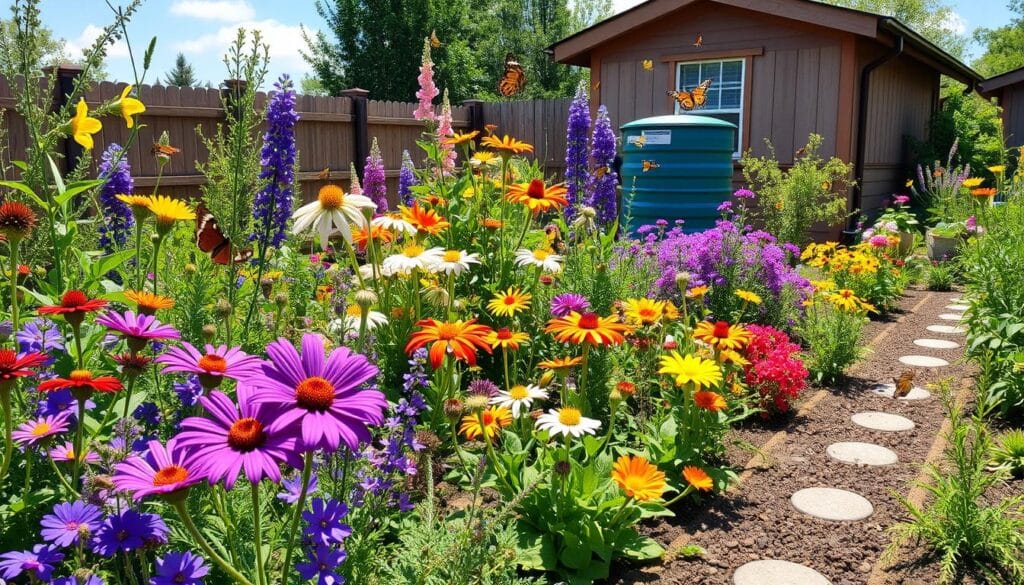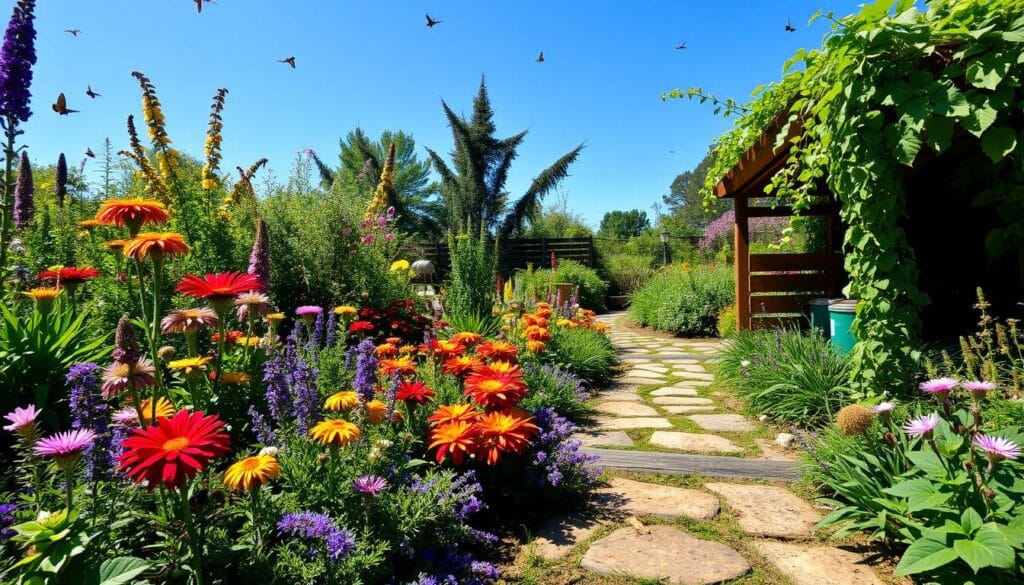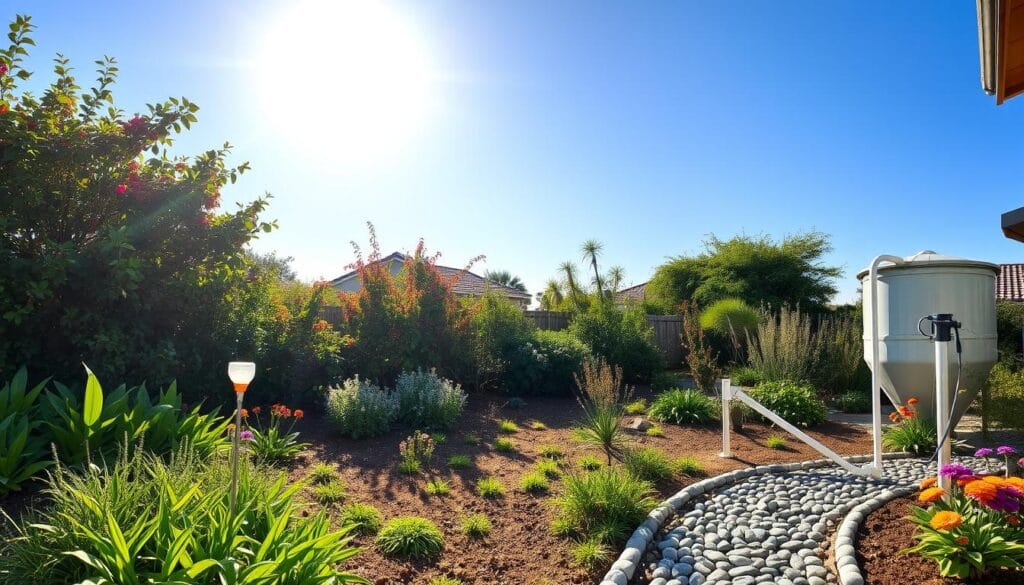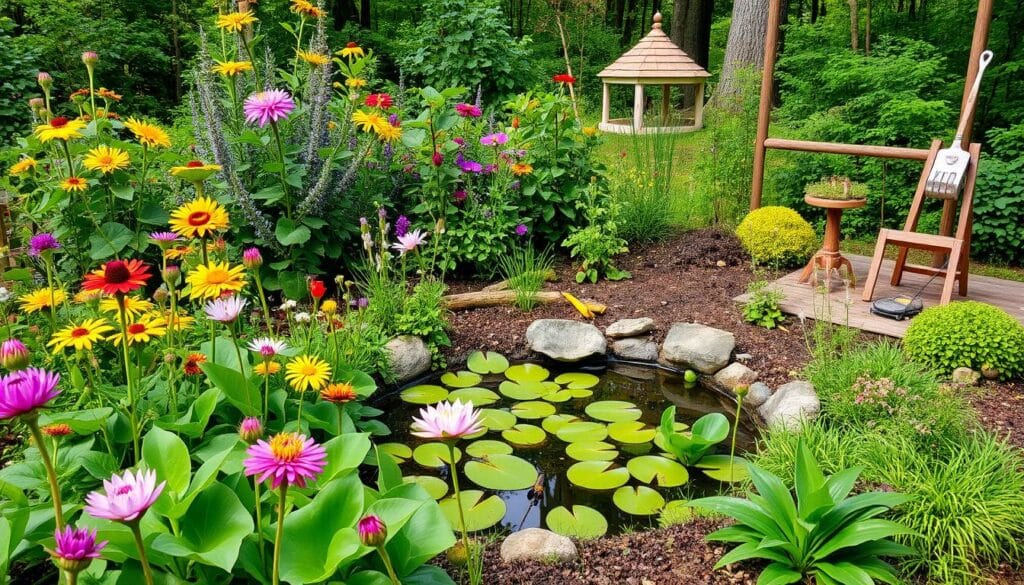Thinking about changing your outdoor space? You might want it to be beautiful, useful, and good for the planet. Sustainable landscaping is a way to do this. It uses eco-friendly gardening that cuts down on water, pesticides, and fertilizers.
By using sustainable landscaping, you can lower your environmental impact. You’ll also save money on upkeep and possibly increase your home’s value.
Sustainable landscaping can make your home up to 25% more energy-efficient. It also makes your home look better. Plus, solar lights can save you up to $146 a year and work even when the power is out.
By choosing drought-tolerant plants and using rain barrels, you can save water. Customizable irrigation heads also help. These steps can greatly reduce your environmental footprint.
Key Takeaways
- Sustainable landscaping can increase energy efficiency by up to 25%
- Solar lighting can save up to $146 per year and remain functional during blackouts
- Sustainable landscaping practices can conserve water and reduce environmental impact
- Using eco-friendly gardening practices can lower maintenance costs and increase property value
- Incorporating recycled materials and green building features can reduce carbon footprint and support biodiversity
- Native plants and drought-tolerant plants are essential for water conservation and sustainability
- Smart irrigation techniques, such as drip irrigation systems, are key to water efficiency
Understanding Sustainable Landscaping
Exploring eco-friendly garden design means learning about sustainable landscaping. It aims to make outdoor spaces healthier and more inviting. These spaces encourage people to spend time outside and interact with their community. At the same time, they have a lower environmental impact.
Using green landscaping practices and environmentally friendly design can cut down your carbon footprint. This way, you can make your outdoor area beautiful and vibrant.
Sustainable landscaping is good for the environment and your wallet. For example, native plants need less water and care, saving money. It also helps agencies save on fuel, water, and labor costs. Key benefits include:
- Reduced greenhouse gas emissions
- Lower water consumption
- Decreased use of harmful chemicals
- Increased biodiversity
- Improved air quality

By choosing sustainable landscaping, you help the environment and enjoy a lovely outdoor space.
What Is Sustainable Landscaping?
Sustainable landscaping uses eco-friendly methods and materials for outdoor spaces. It includes using native plants and reducing water and chemical use. This approach creates a thriving ecosystem that benefits the environment and the community.
Benefits of Sustainable Landscaping
Sustainable landscaping offers many advantages. It reduces environmental harm and makes spaces healthier and more inviting. It encourages people to spend time outside and interact with others. Key benefits include better air quality, more biodiversity, and less greenhouse gas emissions.
Common Misconceptions
Many think sustainable landscaping costs more than traditional methods. But, while it might start with a bigger investment, it saves money in the long run. It also reduces environmental harm. By using green practices and design, you can create a beautiful outdoor space that’s good for you and the planet.
Choosing Native Plants for Your Garden
When designing sustainable outdoor spaces, native plants are key. They’ve grown with local wildlife for thousands of years. This makes them perfect for a garden that helps wildlife and keeps biodiversity alive.
Native plants need less care than others once they’re settled. They don’t need extra water, which saves water and is good for the environment. They also help pollinators like bees and butterflies, thanks to their long history together.
Why Native Plants Matter
Native plants are vital for many animals. They offer homes and food, and they’re adapted to the local weather. This means they use less water than other plants, helping to save water.

Popular Native Plants by Region
Choosing the right native plants is important. Look for ones that fit your area. Eastern columbine, for example, is great for pollinators. Deer-resistant plants are also good choices.
Local gardens, plant societies, and extension services can help you find the right plants. By using native plants, you make your garden a haven for wildlife. It’s a key part of sustainable garden solutions and makes your outdoor space beautiful and eco-friendly.
Conserving Water in Landscaping
Starting your sustainable landscaping journey means saving water is key. Using eco-friendly methods can cut down your water use a lot. Rain barrels are great for catching and using rainwater for plants. This saves water and helps prevent stormwater runoff.
Choosing plants that don’t need much water is another smart move. Smart irrigation systems also help by giving plants just the right amount of water. This cuts down on waste and saves money on your water bill.

- Reduced water bills
- Lower maintenance costs
- Increased property value
- Environmental benefits, such as reduced stormwater runoff and preserved natural habitats
By using eco-friendly landscaping, you can make your outdoor space beautiful and green. You’ll also save a lot of water.
| Water Conservation Method | Water Savings |
|---|---|
| Xeriscaping | 50-75% |
| Rainwater Harvesting | Up to 1,300 gallons per inch of rain |
| Drip Irrigation Systems | Up to 90% |
Promoting Biodiversity in Your Yard
Starting your eco-friendly gardening journey means focusing on biodiversity. Green landscaping practices help create a space that supports local wildlife. This makes your yard more beautiful and beneficial for the environment.
Planting native species is key. These plants are good for the environment and help pollinators. You can also create habitats for wildlife and attract pollinators.

Even small changes can help a lot. For example, a 10-square-foot area with native plants can greatly support biodiversity. These practices make your yard healthier and support the local environment.
| Strategy | Benefits |
|---|---|
| Planting native species | Supports local wildlife, enhances ecosystem health |
| Creating habitats for wildlife | Provides shelter, food, and water for animals |
| Attracting pollinators | Supports plant reproduction, enhances ecosystem health |
Using these eco-friendly gardening strategies makes your yard beautiful and sustainable. It supports biodiversity and helps the environment.
Utilizing Organic and Natural Practices
Creating an environmentally friendly landscape design means using organic and natural practices. This approach is good for the environment and supports sustainable gardening. Organic gardening reduces the need for harmful chemicals, protecting wildlife and soil.
Organic gardening improves soil health and boosts biodiversity. It also cuts down on pollution. You can use compost and manure to feed your plants. Natural pest control methods, like introducing beneficial insects, are also effective.
Organic Gardening Benefits
Organic gardening has many advantages:
- It makes soil more fertile and structured.
- It leads to higher crop yields and better plant health.
- It reduces soil erosion and water pollution.
- It increases biodiversity and ecosystem services.
Common Organic Pest Control Methods
Here are some organic pest control methods:
- Neem oil or insecticidal soap can control insects.
- Beneficial insects, like ladybugs or lacewings, can prey on pests.
- Physical barriers, like fine mesh or netting, can keep pests away.
Using these organic and natural practices helps create a sustainable garden. It benefits the environment and supports a healthy ecosystem.
| Organic Gardening Method | Benefits |
|---|---|
| Composting | Improves soil fertility and structure, reduces waste |
| Natural Pest Control | Reduces environmental pollution, promotes biodiversity |
| Native Plant Species | Conserves water, reduces maintenance, promotes ecosystem services |
Sustainable Hardscaping Options
When designing your outdoor space, think about the environment. Sustainable hardscaping options can lower your carbon footprint. They also make your space beautiful and useful. Eco-friendly landscaping techniques help create a space that’s good for the planet and improves your life.
Eco-Friendly Materials for Patios and Paths
Using eco-friendly materials for patios and paths is a smart choice. Some great options include:
- Locally sourced and reclaimed materials, which reduce transportation emissions and support the local economy
- Recycled materials, such as recycled concrete or brick, which conserve natural resources and reduce waste
- Permeable pavers, which allow rainwater to percolate into the ground, reducing stormwater runoff and replenishing the soil
Low-Impact Driveway Solutions
Choosing low-impact driveway solutions is also key. Materials like gravel or decomposed granite are good because they let water drain naturally. They also cut down on the need for stormwater management systems. You can also use recycled materials, such as recycled asphalt or concrete, for a durable and green driveway.
By using sustainable hardscaping options, you can make a space that’s both beautiful and eco-friendly. Pick materials that are good for the planet, choose low-impact driveways, and always think about sustainability in your landscaping.
| Material | Benefits |
|---|---|
| Locally sourced materials | Reduced transportation emissions, supports local economy |
| Recycled materials | Conserves natural resources, reduces waste |
| Permeable pavers | Reduces stormwater runoff, replenishes soil |
Energy Efficiency in Landscape Design
Energy efficiency is key in sustainable landscaping. Eco-friendly gardening can cut down your energy use and lower bills. Planting trees on the south and west sides of your property can block sunlight in summer, saving energy.
Using permeable surfaces helps manage water and cuts down on stormwater runoff. This is good for the environment and saves energy by reducing the need for artificial watering. Ground covers and shrubs also help keep temperatures steady indoors, saving energy. These strategies make your outdoor space more energy-efficient and sustainable.
- Planting fast-growing vines to create shade and reduce heat absorption by walls
- Installing rain barrels and cisterns to reduce water usage for irrigation
- Using drought-tolerant plants to lower watering expenses
- Incorporating solar-powered outdoor lights to decrease traditional electricity reliance
By using these eco-friendly gardening practices, you can make a sustainable and energy-efficient landscape. This not only helps the environment but also saves you money on utility bills.
| Strategy | Energy Savings |
|---|---|
| Planting deciduous trees | Up to 10-15% |
| Using permeable surfaces | Up to 50-70% reduction in water runoff |
| Installing solar-powered outdoor lights | Up to 70% decrease in traditional electricity reliance |
Soil Health and Fertility
Exploring green landscaping means understanding soil health and fertility. Sustainable gardens depend on soil, which can hold three times as much carbon as the atmosphere. By using regenerative agriculture, you help the soil, sequester carbon, and support the environment.
Soil fertility is key for farming and gardening. It needs nutrients, minerals, and organic matter. Adding compost or manure improves fertility and keeps moisture in. Minimal tillage and mulching also help by keeping moisture in and preventing erosion.
- Crop rotation to prevent nutrient depletion and enhance soil health
- Using organic fertilizers like compost, manure, and cover crops
- Minimal soil disturbance through no-till farming to preserve soil structure
- Mulching to conserve moisture and prevent erosion
These sustainable garden solutions help create a thriving ecosystem. They support biodiversity and prevent erosion and nutrient runoff. Healthy soil is essential for feeding the world’s growing population.
Seasonal Maintenance for Sustainability
Creating an eco-friendly garden is a big step. It’s key to think about seasonal care for your outdoor space. This means adjusting your garden care to match each season. This keeps your garden healthy and green all year.
Seasonal care is vital. In spring, focus on flowers, mulching, and checking your irrigation system. Summer needs lawn care, pest control, and pretty planters. Fall is for changing colors, moving plants, and keeping up with garden tasks.
Some important tasks include:
- Spring cleanup and flower planting
- Summer lawn care and pest control
- Fall seasonal color changes and perennial transplanting
These steps help keep your soil healthy, save water, and support a lively garden ecosystem.
Using native plants, mulch, and water-saving systems is key. These practices reduce harm to the environment. By doing these things and keeping up with seasonal care, you’ll have a beautiful, green space that’s good for you and the planet.
| Season | Maintenance Tasks |
|---|---|
| Spring | Spring cleanup, flower planting, mulching, drainage maintenance, irrigation system checks |
| Summer | Lawn care, pest control, enhanced planters, hardscaping projects |
| Fall | Seasonal color changes, perennial transplanting, ongoing maintenance activities |
Incorporating Edible Landscaping
Exploring eco-friendly gardening and sustainable landscaping? Think about adding edible landscaping to your yard. It gives you fresh food, boosts biodiversity, and cuts down on environmental harm. Edible landscaping mixes plants you can eat with those you can’t, making your garden both pretty and useful.
Edible landscapes blend plants like fruits, veggies, and herbs with flowers. For instance, basil and tomatoes together improve taste and keep bugs away. Other great choices include rosemary, thyme, mint, lettuce, carrots, peppers, and citrus trees. This variety makes your garden strong and easy to care for.
- Fresh, nutrient-dense produce right in your own backyard
- Increased physical activity and reduced stress through gardening
- Opportunities for community engagement and local food swaps
- Potential to reduce grocery bills and minimize food waste
By using eco-friendly gardening and landscaping, you can make a garden that’s good for you and the planet. With some creativity and planning, your yard can become a lush, productive space.
Inspiring Examples of Sustainable Landscapes
The world is waking up to the need to protect our environment. This has made sustainable landscaping very popular. In fact, there’s been an amazing 80% increase in demand for green landscaping techniques.
In the United States, many projects show the power of sustainable landscaping. They use sustainable garden solutions like collecting rainwater, choosing native plants, and using permeable paving. For example, a design in Seattle, Washington, uses 97% native plants. It has cut water use by 65% compared to old landscaping.
Want to make your outdoor space more sustainable? Think about using drought-resistant plants, which can save up to 50% on water. Also, rock gardens need much less care than lawns, cutting down time and effort by 75%.
By learning from these projects, you can make your own eco-friendly outdoor space. It will be beautiful and good for the planet. Sustainable landscaping is here to stay, shaping the future of outdoor design.
FAQ
What is sustainable landscaping?
Sustainable landscaping is a way to design and care for outdoor spaces. It uses native plants, saves water, and controls pests naturally. This approach makes gardens healthy, easy to maintain, and good for the environment.
What are the benefits of sustainable landscaping?
Sustainable landscaping has many advantages. It cuts down on water, pesticide, and fertilizer use. It also saves money and boosts property value. Plus, it makes spaces healthier and encourages people to spend time outside.
What are some common misconceptions about sustainable landscaping?
Some people think sustainable landscaping is only for the environment. They also believe it costs more and is hard to keep up. But, it can be affordable and easy to care for while being beneficial.
Why are native plants important in sustainable landscaping?
Native plants fit well with local weather and soil. They need less water and fight off pests better. Using native plants helps local ecosystems and biodiversity.
What are some water conservation techniques for sustainable landscaping?
To save water, sustainable landscaping uses rain gardens and drip irrigation. It also picks plants that don’t need much water. These methods save water, cut down on upkeep, and lower bills.
How can I promote biodiversity in my sustainable landscape?
To boost biodiversity, create wildlife habitats and use companion planting. Also, add plants that attract pollinators. These steps help your ecosystem and landscape health.
What are the benefits of organic gardening and natural pest control in sustainable landscaping?
Organic gardening and natural pest control improve soil health and reduce pollution. They make gardens safer for people and animals. These methods keep your landscape’s ecological balance.
What are some sustainable hardscaping options?
For sustainable hardscaping, use eco-friendly materials like permeable pavers or decomposed granite. These materials are good for the environment and make outdoor spaces look better.
How can I improve energy efficiency in my landscape design?
To save energy, place trees for shade and use permeable surfaces. These steps lower energy use and bills. They make your landscape more efficient.
Why is soil health important in sustainable landscaping?
Healthy soil is key to a sustainable garden. Use compost and mulch to improve it. This supports plant growth and makes your garden more resilient.
How can I maintain a sustainable garden throughout the year?
Keep your garden healthy with seasonal care like pruning and mulching. Know what your plants need each season. This keeps your garden thriving all year.
What is edible landscaping, and how can I incorporate it into my sustainable garden?
Edible landscaping mixes food plants into your garden design. It adds fresh produce and boosts biodiversity and beauty. It’s a great way to make your garden more useful and interesting.
Source Links
- 20 Sustainable Landscaping Ideas for an Eco-Friendly Home – https://bkvenergy.com/blog/sustainable-landscaping-ideas/
- Sustainable Landscape Design: 5 Easy Steps to Eco-Friendly Outdoor Spaces – https://kndlandscaping.com/designing-sustainable-landscapes/
- Four Benefits of Sustainable Landscaping: Using Native Plants – https://thelawrencegroup.com/four-benefits-of-sustainable-landscaping-using-native-plants/
- Sustainable Landscape Management for Parks – https://productiveparks.com/sustainable-landscape-management-parks
- Native Plants: Everything You Need to Know – https://content.gardenforwildlife.com/learn/native-plants-everything-you-need-to-know
- Embracing Native Plants: A Guide to Choosing and Caring for Local Flora – https://starkiebrosgardencenter.com/blogs/news/embracing-native-plants-a-guide-to-choosing-and-caring-for-local-flora?srsltid=AfmBOoqLMYsgC_Xp0GqZgPSrmzyW1SCmrhyxtwdLXW8FYuL3_MskbuO2
- Innovative Water-Saving Techniques For Eco-Friendly Landscaping – https://dtelandscape.com/innovative-water-saving-techniques-for-eco-friendly-landscaping/
- Sustainable Landscape Water Conservation – https://www.caibaycen.com/blog/sustainable-landscape-water-conservation
- Water-Efficient Landscapes: Combining Aesthetics with Sustainability – GLOBE-Net – https://globe-net.com/water-efficient-landscapes-combining-aesthetics-with-sustainability/
- 8 Ways to Encourage Biodiversity in Your Yard – https://www.lawnstarter.com/blog/landscaping/ways-to-encourage-biodiversity/
- increasing biodiversity by creating an eco-friendly yard – Nature Forward – https://natureforward.org/increasing-biodiversity-by-creating-an-eco-friendly-yard/
- Boost Urban Biodiversity with Landscape Design Principles – https://landscapeofus.com/landscaping/landscape-design-biodiversity/
- Eco-Friendly Landscaping Techniques for RV Resorts – https://crrhospitality.com/blog/eco-friendly-landscaping-techniques-for-rv-resorts/
- Practices for Environmentally Friendly Landscaping – Hemlock Landscapes – https://www.hemlocklandscapes.com/landscaping-tips/practices-for-environmentally-friendly-landscaping/
- Sustainable Hardscaping Options for Your Home – https://www.thedreamscapes.com/blog/sustainable-hardscaping-options-for-your-home
- Sustainable landscaping: A comprehensive guide to eco-friendly materials – McNeil Engineering – https://www.mcneilengineering.com/sustainable-landscaping-a-comprehensive-guide-to-eco-friendly-materials/
- Smart Landscaping: How to Design Your Yard for Maximum Energy Savings – https://www.apge.com/blog/smart-landscaping-how-to-design-your-yard-for-maximum-energy-savings
- Energy-efficient landscaping – https://en.wikipedia.org/wiki/Energy-efficient_landscaping
- Top Tips for Creating an Energy-Efficient Landscaping Design – https://energysavings.com/blog/energy/top-tips-energy-efficient-landscaping-design/
- How to Build Soil Health With No-Till Regenerative Gardening – https://www.ecofriendlyhomestead.com/sustainable-garden/learn/build-soil-health-fertility-with-these-eco-friendly-gardening-practices
- Enhancing Soil Health For Lasting Success In Sustainable Landscaping | Legacy Landscape Design – https://legacylandscapes.com/sustainable-landscaping/
- Understanding Soil Fertility: A Key to Sustainable Agriculture – KCOA – https://kcoa-africa.org/understanding-soil-fertility-a-key-to-sustainable-agriculture/
- Seasonal Landscaping Strategies for Commercial Properties: A Year-Round Guide – https://levelgreenlandscaping.com/blog/seasonal-landscaping-strategies-commercial-properties-year-round-guide
- Landscape sustainability checkup – https://extension.oregonstate.edu/gardening/techniques/landscape-sustainability-checkup
- Incorporating edible plants into your landscape – Yandllandscaping.com – https://www.yandllandscaping.com/blog/incorporating-edible-plants-into-your-landscape
- Creating a Permaculture-Inspired Edible Landscape – https://www.tenthacrefarm.com/see-how-easily-you-can-create-an-edible-landscape/
- Sustainable Landscape Design Ideas: Minimize Your Impact While Maximizing Your Yard – https://www.landscapesandmore.com/blog/sustainable-landscape-design-ideas:-minimize-your-impact-while-maximizing-your-yard/27
- Sustainable Landscape Design – Sources of Inspiration – https://ewspconsultancy.com/2024/07/01/sustainable-landscape-design-sources-of-inspiration/
- Top 2024 Landscape Trends: Eco-Friendly Designs and Sustainable Solutions | Kodiak Landscape Design Inc. is the premier landscaping company. Call us for service at 973-831-7799. – https://www.kodiaklandscapedesign.com/top-2024-landscape-trends-eco-friendly-designs-and-sustainable-solutions/
- Repurposing Garden Waste: Creative Ways to Reuse and Recycle

